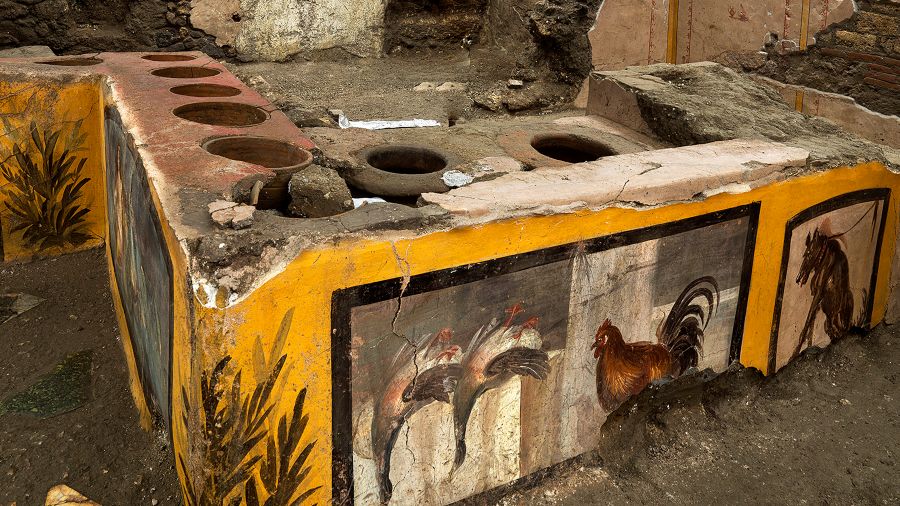
Scientists found in the voids of the table food scraps that could provide valuable information about the gastronomic customs of the place.
The archeological area of Pompeii, the city destroyed in 79 AD. by the eruption of Vesuvius is not surprising and this Saturday was announced the discovery of a thermopolium (thermopolium), a kind of “fast food” in the middle of the street in ancient Rome, where food was served and drink to the inhabitants, which is intact and decorated and with still remnants of food.
The Italian Ministry of Culture and the archaeological area announced that they considered “another extraordinary discovery in Pompeii, in the new excavations undertaken within the project of maintenance and restoration of the Regio V”.
The counter preserved by volcanic ash had been partially unearthed in 2019, but work was extended to try to preserve the entire archaeological site as best as possible, and which is located in a busy neighborhood, at the intersection of the streets of Les Noces d ‘silver and that of Les Balconades.
This is a thermopolium, where food was usually served to the lower classes of the city, perfectly preserved with the counter with the image of a sea nymph on horseback and other animals with such bright colors that look three-dimensional, they explain, among the which include poultry, such as hens and mallards, which were to be watered with wine or hot drinks.
YOU MAY BE INTERESTED IN: 5 scientific discoveries that have gone unnoticed since the coronavirus emerged
But what has most surprised archaeologists is the discovery in the packaging with leftovers of this food that was sold on the street and which is the origin of “takeaway food.”

The counter buried by volcanic ash had been partially unearthed in 2019, but work was extended to better preserve the entire site. Photo / AFP
Scientists found in the voids of the table food scraps that could provide valuable information about the gastronomic customs in Pompeii at the time when Vesuvius erupted, in the year 79 AD.
A fragment of duck bone was recovered at the site, as well as remains of pigs, goats, fish and snails in clay containers. Several ingredients were cooked together, as if it were a frying pan.
At the bottom of a bowl were chopped beans, which were used to modify the taste of the wine.
YOU MAY BE INTERESTED IN: A new face of Jewel of Ceren, Pompeii of America
“In addition to being a witness to daily life in Pompeii, the possibilities of analyzing this thermopolium are exceptional, as for the first time a whole set has been unearthed,” rejoices Massimo Osanna, director General of Pompeii Archaeological Park, in a statement.
Near the site were found amphorae, a cistern and a fountain, as well as human bones, including those of a man in his 50s, near a child’s crib.
“The thermopolium has the effect of having been hastily closed and abandoned by its owners, although it is possible that someone, perhaps the oldest man, stayed and died during the first stage of the eruption, in l ‘collapse the attic,’ Osanna said in an interview with local news agency Ansa.
The other skeleton could be that of a thief or some hungry fugitive, “surprised by the burning vapors holding in one hand the lid of the container he had just opened,” he added.
The “thermopolia” (the compound word comes from the Greek ‘thermopōlion’, which means hot food to sell) were very common in the Roman world. In Pompeii alone there were about 80.
The city, completely covered by the eruption of Vesuvius in 79, is the second most visited place in Italy after the Roman Colosseum, with almost four million visits in 2019.
So far, only a third of the site, which currently extends over some 44 hectares not far from Naples, has been unearthed by archaeologists.
YOU MAY BE INTERESTED IN: Find “unique”: Discover in Jerusalem an underground complex two thousand years old